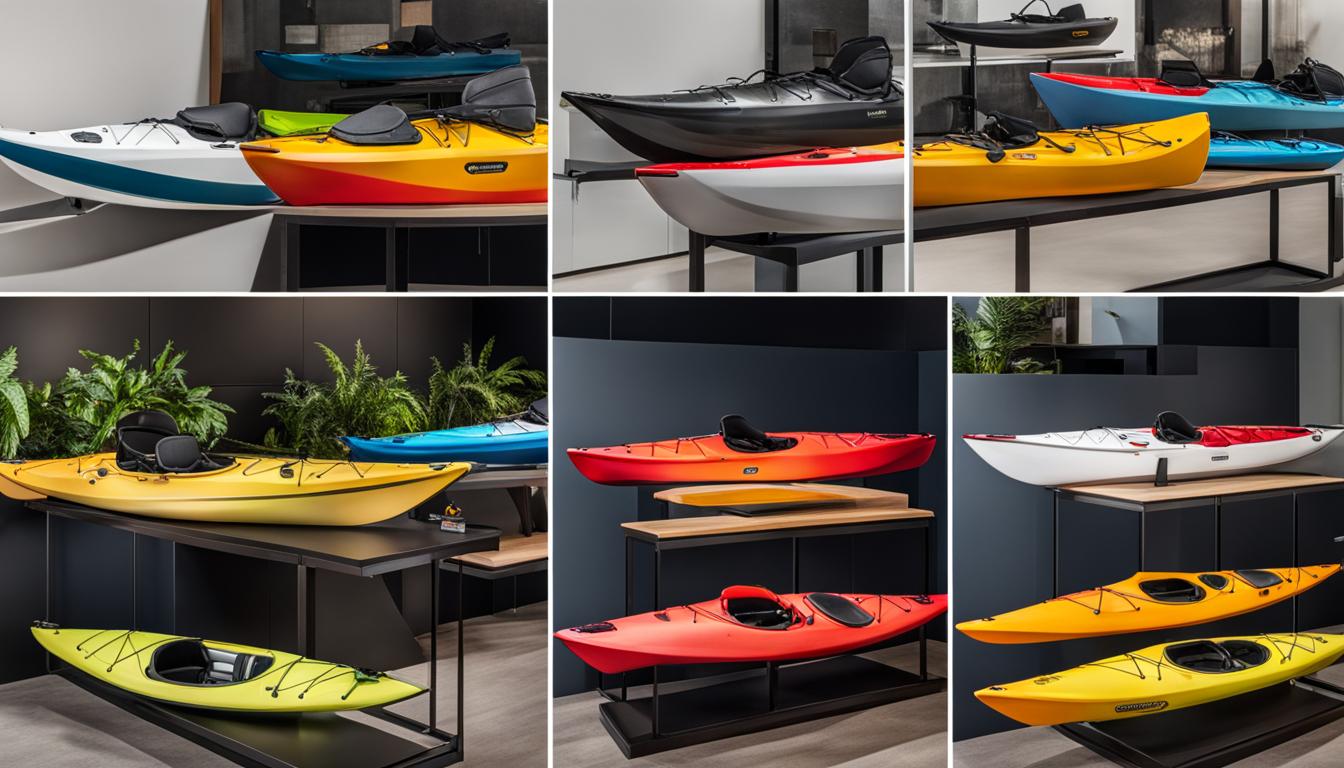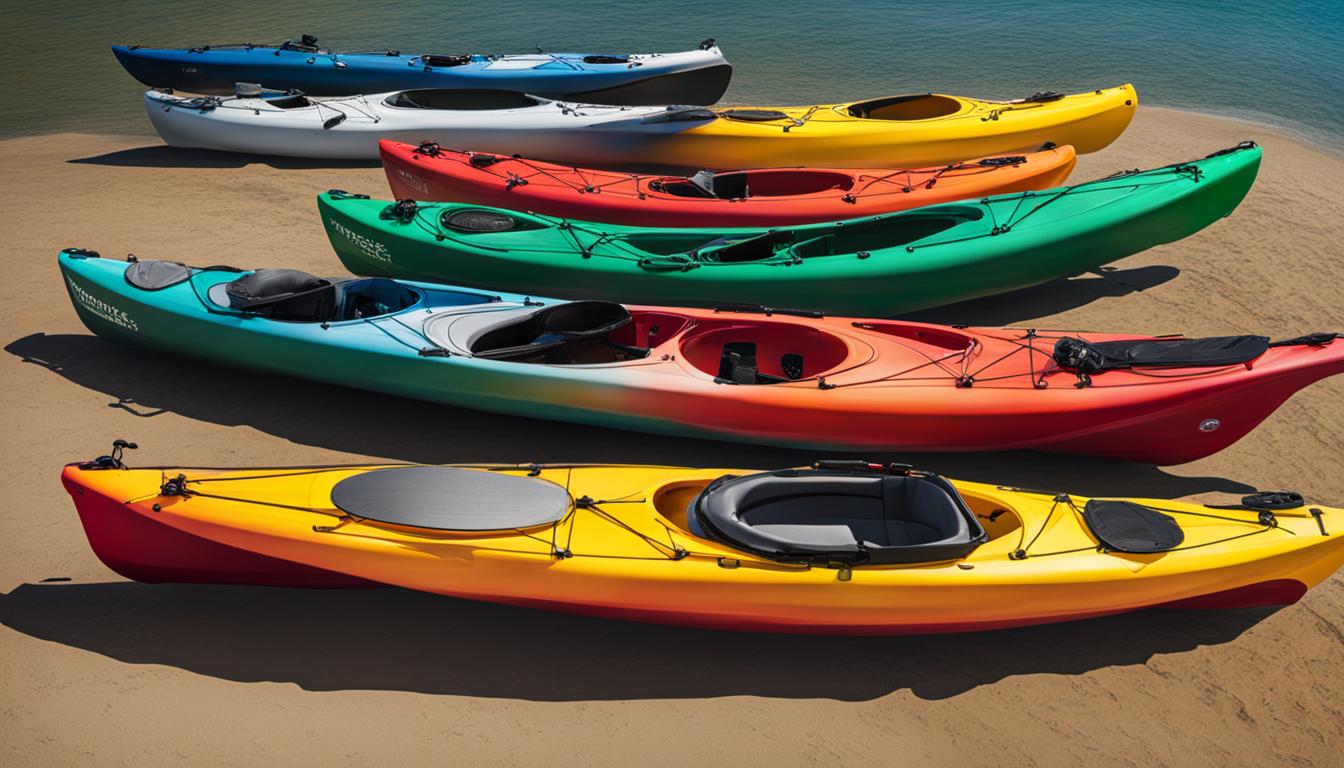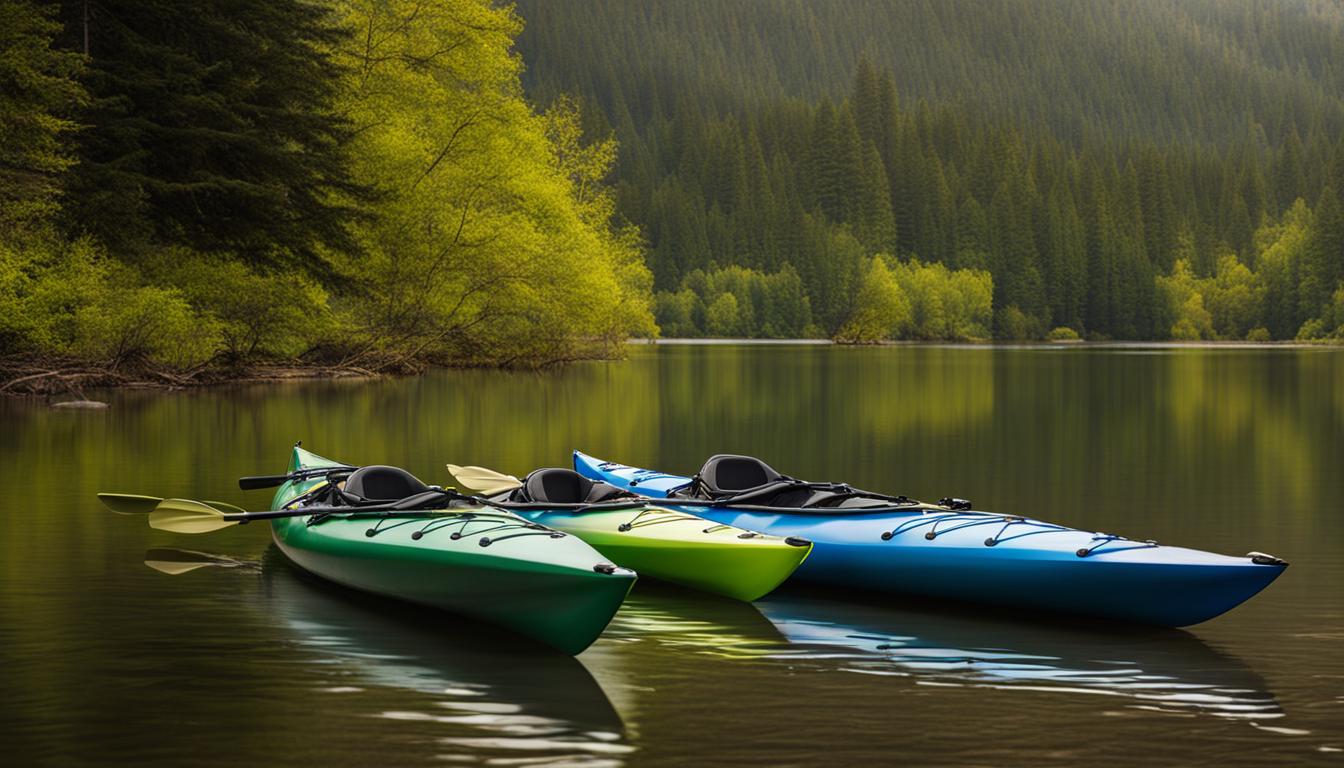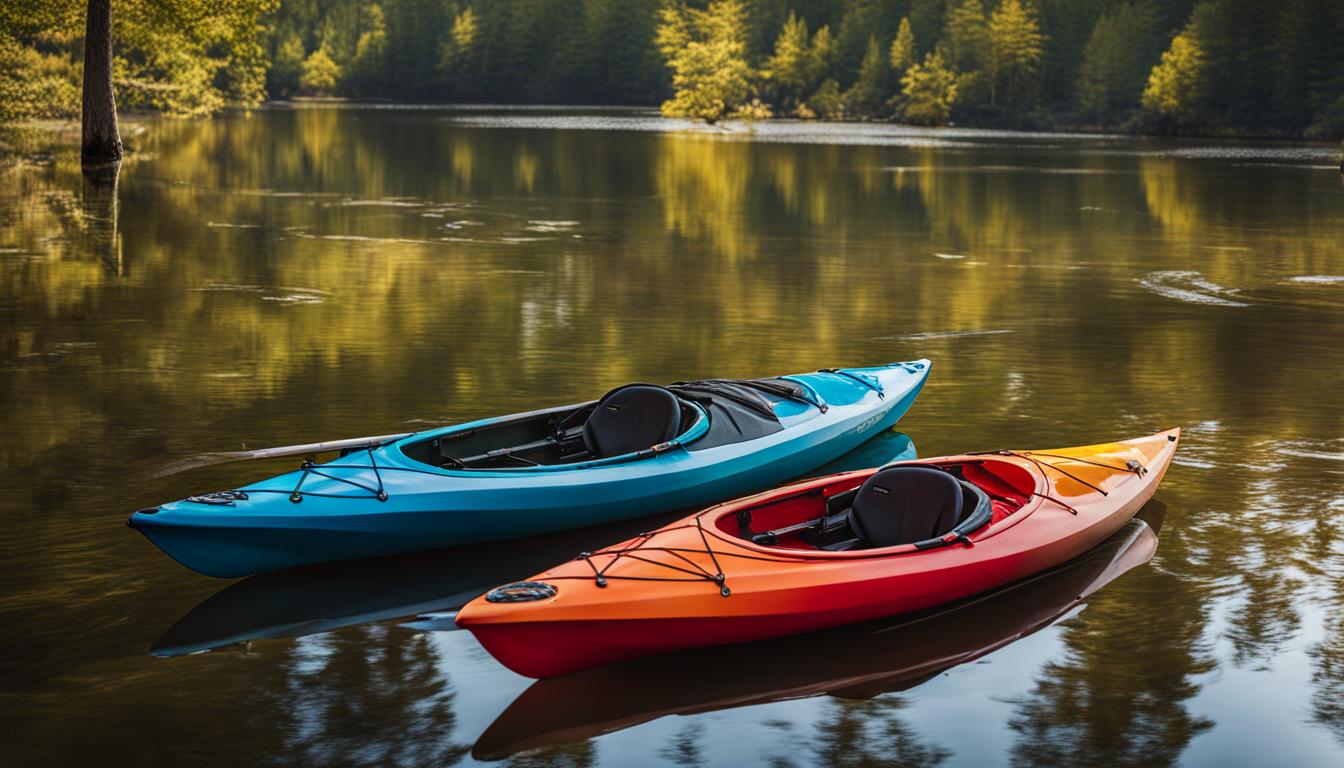When it comes to kayaking, the build quality and materials of your kayak can make all the difference in your experience on the water. The right kayak material can enhance performance, ensure durability, and provide an overall high-quality paddling experience. In this article, we will dive into the world of kayak materials, explore their impact on build quality, and help you understand what to look for when assessing the material quality of a kayak.
Key Takeaways:
- Choosing the right kayak material is essential for performance and durability.
- Assessing the quality of kayak materials is crucial before making a purchase.
- Durable kayak materials can ensure a long-lasting and enjoyable paddling experience.
- Consider factors like budget and intended use when selecting the best kayak material.
- Understanding the pros and cons of different kayak materials is key to making an informed decision.
Hard-Shell Kayak Materials
When it comes to hard-shell kayaks, there are several materials to choose from, each with its own strengths and weaknesses. Understanding these materials can help you make an informed decision when selecting the right kayak for your adventures on the water.
Rotomolded Polyethylene Kayaks
One of the most popular and widely used materials for hard-shell kayaks is rotomolded polyethylene. This material offers excellent durability, making it a great choice for recreational kayakers and beginners. Rotomolded polyethylene kayaks are known for their toughness and resistance to impacts, making them ideal for navigating rocky rivers or shallow waters. Additionally, these kayaks tend to be more affordable compared to other materials.
Thermoform Kayaks
Thermoform kayaks provide a middle ground between polyethylene and composite kayaks. They are constructed by vacuum-forming a sheet of ABS plastic over a mold, resulting in a lightweight and glossy finish. Thermoform kayaks are known for their durability, impact resistance, and UV stability. They are also easier to repair compared to composite kayaks. While thermoform kayaks may not offer the same level of performance as composite kayaks, they provide a balance between durability and weight, making them suitable for recreational paddlers.
Composite Kayaks
Composite kayaks are the top choice for performance-oriented paddlers. These kayaks are constructed using materials such as fiberglass, carbon fiber, and aramid, resulting in a lightweight and rigid hull. Composite kayaks offer excellent maneuverability, speed, and responsiveness on the water. However, they tend to be more expensive and require more careful handling and maintenance compared to other materials. If you are an experienced kayaker looking for optimal performance, composite kayaks are worth considering.
Wooden Kayaks
While less common than the other materials, wooden kayaks offer a unique aesthetic appeal and customization options. Crafted by enthusiasts, wooden kayaks showcase the artistry of boat-building. They are typically made from marine-grade plywood or cedar strips, meticulously assembled to create a strong and lightweight hull. Wooden kayaks require regular maintenance to protect the wood from water damage, but they offer a rewarding paddling experience for those who appreciate the craftsmanship and beauty of traditional boat construction.
Choosing the Right Material
When selecting a hard-shell kayak material, consider factors such as your paddling style, budget, and intended use. If durability and affordability are your primary concerns, rotomolded polyethylene kayaks are a reliable choice. If you value a balance between durability and weight, thermoform kayaks are a suitable option. For performance-driven paddlers with a larger budget, composite kayaks offer unparalleled speed and maneuverability. Lastly, if you appreciate the artistry and customization options, wooden kayaks provide a unique and aesthetically pleasing choice.
Now that we’ve explored the different hard-shell kayak materials, let’s move on to Section 3 to learn about folding and inflatable kayak materials.
Folding and Inflatable Kayak Materials
In recent years, folding and inflatable kayaks have gained popularity among paddling enthusiasts due to their portability and convenience. These kayaks offer the flexibility to easily transport and store them, making them ideal for those who don’t have access to large storage spaces or frequently travel to different water bodies. To ensure their durability and performance, folding and inflatable kayaks are constructed using specific materials.
When it comes to inflatable kayaks, they are typically made from durable materials such as PVC or urethane-coated fabrics. These materials provide excellent puncture resistance, ensuring that your kayak can withstand various water conditions and potential impacts. The construction of inflatable kayaks involves multiple air chambers that provide stability and buoyancy. Inflating and deflating the kayak is a straightforward process, allowing you to quickly inflate it before your adventure and effortlessly deflate it for storage.
On the other hand, folding kayaks are designed to be lightweight and compact while still maintaining the necessary strength and rigidity. These kayaks are constructed using high-strength materials such as aluminum frames and rugged fabrics. The frame provides structural integrity, while the fabric skin adds durability and protection against the elements. Folding kayaks can be assembled and disassembled easily, allowing you to pack them into a compact carrying bag or backpack.
Comparison of Folding and Inflatable Kayak Materials
| Folding Kayaks | Inflatable Kayaks |
|---|---|
| Constructed with aluminum frames and rugged fabrics | Made from durable materials like PVC or urethane-coated fabrics |
| Offers excellent strength and rigidity | Provides excellent puncture resistance |
| Lightweight and compact for easy transport and storage | Highly portable and can be deflated for compact storage |
| Assembled and disassembled quickly | Easily inflated and deflated |
Whether you choose a folding or inflatable kayak, both options provide unique advantages for different paddling needs. Folding kayaks are favored for their lightweight construction and ease of assembly, making them suitable for kayakers who value portability. Inflatable kayaks, on the other hand, are valued for their puncture resistance and quick inflation/deflation capabilities.
When deciding between folding and inflatable kayaks, consider factors such as your paddling preferences, storage limitations, and the conditions you’ll be kayaking in. Both options offer reliable performance and can provide memorable experiences on the water. So, choose the kayak that aligns with your needs and embark on your next adventure!
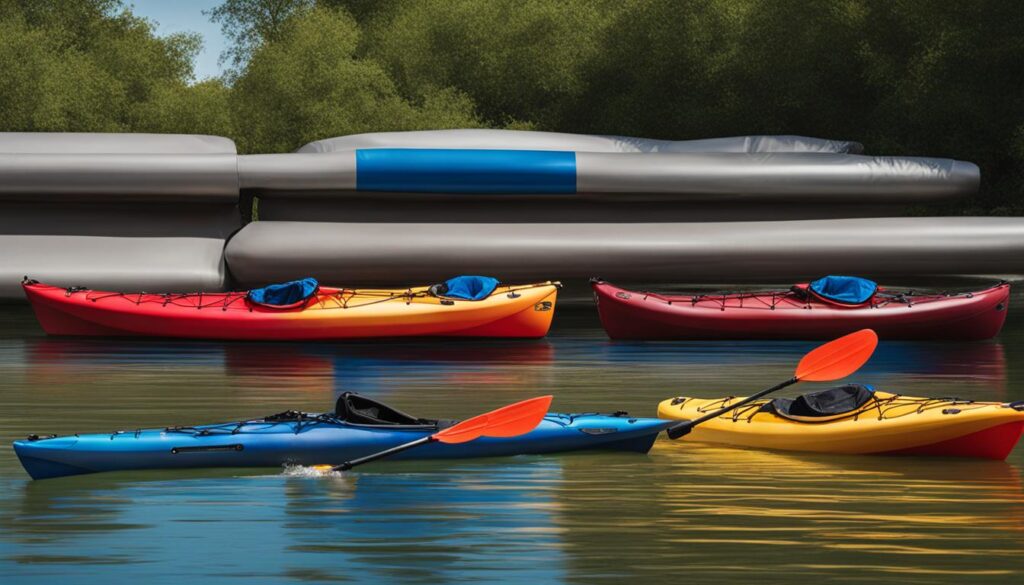
Best Kayak Material: A Comparison of Construction Quality
When it comes to choosing the best kayak material, there are several factors to consider. Each type of material has its own unique characteristics, strengths, and weaknesses. To help you make an informed decision, let’s compare the most common kayak materials and assess their construction quality.
Types of Kayak Materials
1. Rotomolded Polyethylene: Rotomolded polyethylene kayaks are known for their durability and affordability. The material is resistant to impact and abrasion, making it ideal for recreational kayaking in various water conditions. However, polyethylene kayaks tend to be heavier compared to other materials, which can affect their speed and maneuverability.
2. Thermoform: Thermoform kayaks offer a balance between durability and weight. The material used in thermoforming, such as ABS or high-impact plastic, provides a lightweight and glossy finish. Thermoform kayaks are more rigid than polyethylene kayaks and offer better performance on the water. However, they may not be as durable and resistant to impact as their rotomolded counterparts.
3. Composite: Composite kayaks are constructed using materials like fiberglass, carbon fiber, and aramid. These materials offer superior performance, rigidity, and responsiveness. Composite kayaks are lightweight, making them ideal for touring, racing, and performance-driven paddling. However, they are more expensive and may require more maintenance to keep them in optimal condition.
Kayak Construction Quality
When evaluating kayak construction quality, it’s important to consider factors such as hull design, deck integrity, and overall build strength. Look for reinforced bulkheads, sturdy hatches, and solid rudder systems, as these features contribute to the kayak’s durability and performance. Additionally, pay attention to the seam quality and finish of the kayak to ensure that it is well-constructed and free of defects.
Ultimately, the best kayak material depends on your specific needs and preferences. If you prioritize affordability and versatility, rotomolded polyethylene kayaks are a great choice. If you value performance and lightweight design, thermoform or composite kayaks may be more suitable. Consider your budget, intended use, and desired performance to find the perfect kayak material that meets your requirements. Happy paddling!
| Kayak Material | Pros | Cons |
|---|---|---|
| Rotomolded Polyethylene | Affordable, durable, impact-resistant | Heavier, less responsive |
| Thermoform | Lightweight, glossy finish, good performance | Less durable, may be prone to impact |
| Composite | Superior performance, lightweight, rigid | Expensive, requires maintenance |
Kayak Deck and Hull Materials
When it comes to kayak construction, the materials used for the deck and hull play a critical role in determining the overall quality and durability of the kayak. The choice of materials can affect factors such as weight, performance, and resistance to wear and tear. In this section, we will discuss the different materials commonly used for kayak decks and hulls and their impact on the kayak’s integrity.
Deck Materials:
Kayak decks can be made from various materials, each with its own characteristics and benefits. Some common kayak deck materials include:
- Molded Plastic: This is a popular choice for entry-level kayaks due to its affordability and durability. Molded plastic decks are resistant to impact and can withstand rough handling.
- Fiberglass: Fiberglass decks offer a balance between weight and strength. They are relatively lightweight and provide a responsive feel on the water.
- Carbon Fiber: Carbon fiber decks are known for their exceptional strength-to-weight ratio. They are lightweight, rigid, and offer excellent performance, making them a preferred choice for high-performance kayaks.
Hull Materials:
The hull, which is the bottom part of the kayak, is equally important in determining the kayak’s performance and durability. Common materials used for kayak hulls include:
- Polyethylene: Polyethylene hulls are widely used due to their durability and affordability. They can withstand impact and are resistant to scratches and abrasions.
- Fiberglass: Fiberglass hulls are popular for their lightweight nature and excellent performance. They offer a smooth glide on the water and are responsive to paddling strokes.
- Composite Materials: Composite hulls, such as those made from fiberglass, carbon fiber, or aramid, offer superior performance and rigidity. They are lighter than polyethylene and provide enhanced responsiveness and speed.
Assessing the integrity of the kayak’s deck and hull materials is crucial for ensuring the kayak’s overall quality and longevity. Look for signs of damage, such as cracks, dents, or delamination. It’s also important to consider the intended use of the kayak and choose materials that align with your desired performance and durability requirements.
Table: Comparison of Kayak Deck and Hull Materials
| Material | Deck | Hull | Pros | Cons |
|---|---|---|---|---|
| Molded Plastic | Yes | Polyethylene | Affordable, durable, impact-resistant | Heavier, limited color options |
| Fiberglass | Yes | Fiberglass | Lightweight, responsive, smooth glide | More expensive than plastic |
| Carbon Fiber | Yes | Composite (carbon fiber) | Lightweight, rigid, excellent performance | High cost, less impact resistance |
| Polyethylene | No | Polyethylene | Affordable, durable, impact-resistant | Heavier compared to composite materials |
| Fiberglass | No | Fiberglass | Lightweight, responsive, smooth glide | More expensive than polyethylene |
| Composite Materials | No | Composite (fiberglass, carbon fiber, aramid) | Superior performance, lightweight | Higher cost, less impact resistance |
The table above provides a comparison of different kayak deck and hull materials, highlighting their pros and cons. It can serve as a helpful guide when considering the right material for your kayak based on your preferences and needs.

Kayak Design Features and Build Strength
When evaluating the build and design of a kayak, there are several key features to consider in order to ensure high quality and durability. These features contribute to the kayak’s overall strength and performance, making it important to assess them before making your purchase. Here are some factors to keep in mind:
Reinforced Bulkheads
Bulkheads are partitions within the kayak that separate different compartments, providing increased buoyancy and stability. High-quality kayaks often have reinforced bulkheads, which are strengthened with additional materials or reinforcements to enhance their structural integrity. This helps prevent water from entering the compartments, ensuring that the kayak remains afloat even in rough water conditions. Additionally, reinforced bulkheads can also provide extra storage space for your gear, allowing you to pack efficiently for your paddling adventures.
Sturdy Hatches
Hatches are openings on the deck of the kayak that provide access to the storage compartments. It is crucial for these hatches to be sturdy and watertight to protect your gear from moisture and ensure their safety during your kayaking trips. Look for kayaks with hatches that feature durable seals or gaskets to keep water out. Additionally, hatches should be easy to open and close securely, allowing for convenient access to your belongings while maintaining the kayak’s integrity.
Solid Rudder Systems
Rudder systems are essential for controlling the direction and stability of your kayak, particularly in windy or choppy conditions. A high-quality kayak will have a solid rudder system that is well-integrated into the design. Look for kayaks with sturdy rudder pedals and reliable cables or tracks that allow for smooth and precise rudder control. A well-designed rudder system enhances maneuverability, making it easier to navigate through different water conditions and enjoy a comfortable paddling experience.
By assessing the design features and build strength of a kayak, you can ensure that you choose a high-quality and durable option that meets your specific needs. Reinforced bulkheads, sturdy hatches, and solid rudder systems are just a few examples of the features to consider when evaluating a kayak’s build and design. Remember to prioritize your own preferences and intended use, as well as the specific demands of your paddling activities, to find the perfect kayak that will provide years of enjoyment on the water.
Considerations for Choosing the Right Kayak Material
When it comes to choosing the right kayak material, there are several factors to consider. Your paddling style, budget, storage limitations, and intended use all play a role in determining the best kayak material for you. Each material has its own unique characteristics and trade-offs, so it’s important to strike a balance between your desired features and the practicality of the material.
One key consideration is durability. If you plan on taking your kayak on rugged rivers or rocky shores, you’ll want a material that can withstand impact and resist abrasion. Rotomolded polyethylene is a popular choice for its excellent durability and affordability. It can handle rough conditions and is less likely to dent or crack compared to other materials.
Weight is another important factor, especially if you need to transport your kayak frequently. Thermoform kayaks are lightweight and offer a glossy finish, making them easier to carry and maneuver. However, if performance is a top priority, composite kayaks made from materials like fiberglass, carbon fiber, or aramid offer superior rigidity and responsiveness. They are often chosen by experienced paddlers looking for speed and agility.
Finally, budget considerations are crucial. Rotomolded polyethylene kayaks tend to be the most affordable option, making them popular among beginners and casual paddlers. Thermoform kayaks offer a mid-range price point, providing a good balance between durability and weight. Composite kayaks, on the other hand, come with a higher price tag due to the advanced materials used in their construction.
Remember, choosing the right kayak material is a personal decision. It’s essential to weigh the trade-offs and prioritize what matters most to you. By considering factors like durability, weight, and budget, you can make an informed choice and find a kayak that suits your needs and preferences.
Table: Kayak Material Comparison
| Material | Durability | Weight | Price |
|---|---|---|---|
| Rotomolded Polyethylene | Excellent | Medium | Affordable |
| Thermoform | Good | Light | Mid-range |
| Composite (Fiberglass, Carbon Fiber, Aramid) | Excellent | Light | High-end |
| Wood | Varies | Varies | Varies |
Conclusion
After considering the pros and cons of different kayak materials, you can confidently choose the one that suits your needs. When comparing kayak materials, take into account factors like durability, weight, and performance.
Durable kayak materials, such as rotomolded polyethylene, offer excellent longevity and versatility at an affordable price. If you value a balance between durability and weight, thermoform kayaks are a great option, providing a lightweight and glossy finish.
For superior performance and responsiveness, composite kayaks made from materials like fiberglass, carbon fiber, and aramid are your best bet. Keep in mind that composite kayaks may come with a higher price tag.
Remember to assess the integrity of the kayak material, paying attention to the deck and hull. Molded plastic, fiberglass, and carbon fiber are commonly used for kayak decks, while polyethylene, fiberglass, and composite materials are popular choices for hull construction. By evaluating the overall build quality and material integrity, you can ensure your kayak is ready to tackle any water condition and paddling adventure.
FAQ
What are the different types of kayak materials?
The different types of kayak materials include rotomolded polyethylene, thermoform, composite (fiberglass, carbon fiber, aramid), and wood.
What are the advantages of rotomolded polyethylene kayaks?
Rotomolded polyethylene kayaks are affordable and offer great durability.
What are thermoform kayaks?
Thermoform kayaks provide a middle ground between polyethylene and composite kayaks, offering a lightweight and glossy finish.
What are the benefits of composite kayaks?
Composite kayaks, made from materials like fiberglass, carbon fiber, and aramid, are known for their performance and rigidity.
Are wooden kayaks a popular choice?
Wooden kayaks, typically built by enthusiasts, offer a unique aesthetic and customization options.
What materials are inflatable kayaks made from?
Inflatable kayaks are typically made from durable materials like PVC or urethane-coated fabrics.
What materials are folding kayaks constructed with?
Folding kayaks are constructed with lightweight and high-strength materials like aluminum frames and rugged fabrics.
What is the best kayak material?
The best kayak material depends on your specific needs and preferences. Each material has its own strengths and weaknesses.
What materials are commonly used for kayak decks?
Common materials for kayak decks include molded plastic, fiberglass, and carbon fiber.
What materials are kayak hulls made from?
Kayak hulls are typically constructed from polyethylene, fiberglass, or composite materials.
How can I assess the overall build quality of a kayak?
Assessing the material integrity of the deck and hull, as well as evaluating design features like reinforced bulkheads and sturdy hatches, can help determine the overall quality and durability of a kayak.
How should I choose the right kayak material?
Consider factors such as your paddling style, budget, storage limitations, and intended use when choosing the right kayak material. Striking a balance between desired features and practicality is key.
What should I consider when evaluating kayak material?
When evaluating kayak material, consider factors such as durability, weight, performance, and how well it aligns with your specific needs.


